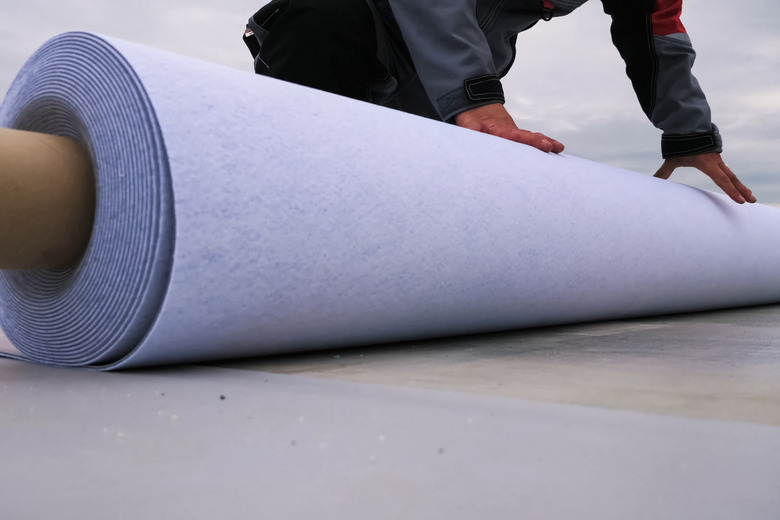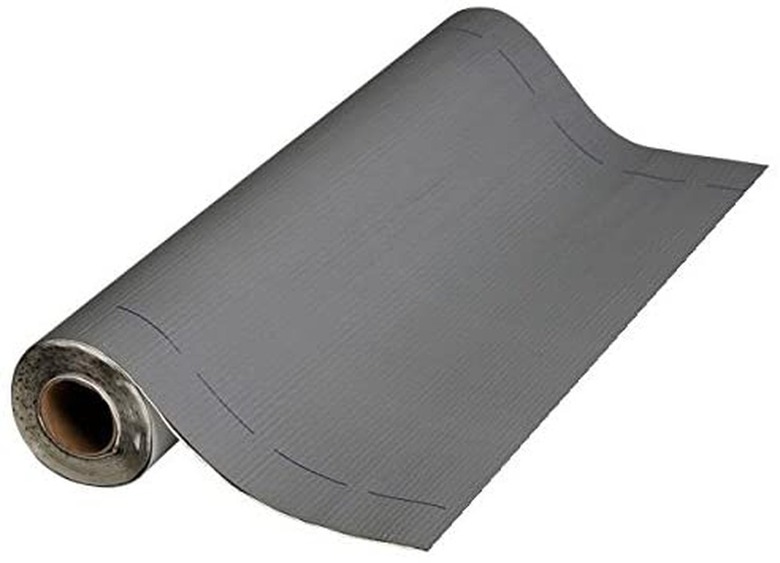A Homeowner's Guide To Roll Roofing
We may receive a commission on purchases made from links.
If you're looking into roofing a home, a garage, or some sort of outbuilding, it may be a good idea to check out a guide on roll roofing but not necessarily because this is the best roofing system across the board. It's just that somewhere along the line, you're sure to hear it mentioned in the same breath as "low cost" and "easy installation" and may find yourself settling on it and heading out to buy a few rolls before you've taken the time to look into what it's actually all about. So, take a step back and read up a bit before hitting your nearest home improvement store.
What Is Roll Roofing?
What Is Roll Roofing?
Water from rain and snow runs down normal asphalt-shingled, sloped roofs to be carried away by a gutter system, but those same shingles used on a low-slope roof will allow water entrance at their edges, thus defeating their purpose. This potential for leakage with lower-sloping roofs is most commonly avoided by using asphalt roll (or rolled) roofing. Also known as MSR — mineral-surfaced roll roofing — it's like asphalt shingles with the same top layer of granules but typically comes in 36-inch-wide, 75-pound rolls. The width results in fewer joints, which reduces leakage, and purchase and installation runs a lot less, but it's thinner and not as long-lasting as asphalt shingles. The typical life span of asphalt roll roofing is five to 15 years with deterioration often becoming apparent at the five-year mark.
Roll roofing is a good thing when used on the right type of roof, but that doesn't usually include houses. It's most often used for outbuildings, sheds, garages, and even treehouses. Due to the product's lack of durability and less-than-appealing appearance, roll roofing will likely decrease the resale value of any house.
Other Types of Roll Roofing
Other Types of Roll Roofing
MSR is most commonly used for residential roofing projects, but it isn't the only type of rolled roofing product out there. Many of the other types are used frequently in commercial applications but can still serve residential purposes. Most have a longer life span than MSR.
TPO
TPO (thermoplastic polyolefin), made of plastics and rubber, is a single-ply roll-roofing material widely used commercially but also for residential applications and even for single-family houses. The white heat-resistant material resists mold, tearing, and puncturing and comes in 6- to 12-foot-wide rolls. TPO has a life span running from 10 to 20 years. Due to a special hot-air welding technique for the seams, this type of roll roofing must be installed professionally. It can be attached in one of three ways: mechanically with roofing nails or screws, with glue, or with ballast. Costs for materials and installation can run from $5.50 to $6 per square foot.
EPDM
Most commonly used on commercial buildings, EPDM rubber membrane, which looks like black inner-tube rubber, is also used residentially on unoccupied buildings, like sheds and garages. It comes closer to being a candidate for DIY than TPO since it requires no special tools or skills, just bonding adhesive and a roller. Rolls measuring 10 x 25 feet are commonly sold, but sheets are available as wide as 50 feet. EPDM, which can last more than 20 years, is black, and even though it's now available in white, it isn't as energy efficient as TPO. The cost per square foot for EPDM can range from $5 to $9.
Modified Bitumen
Modified bitumen is a multilayer roll roofing system made of hot asphalt combined with rubber and plastic additives between fiberglass or polyester sheets. With a life span as long as 30 years, it's superior to other types of rolled roofing products, but it's expensive and involves a complicated and difficult installation process that requires the expertise of a professional roofing contractor. The cost for installed modified bitumen roofing runs from $4.25 to $6 per square foot.
Know Your Slope
Know Your Slope
Because roll roofing is mostly used for low-slope roofs, understanding the principles of roof slope, or the incline of your roof, is crucial when considering whether this type of product is suitable for your roofing project.
Slope is typically expressed as the ratio of the vertical rise to the horizontal run — how many inches the roof rises for every 12 inches of run. The higher the first number (the rise), the steeper your sloped roof. Ratios of 2:12 to 4:12 place a roof in the low-slope category, making it a good candidate for roll roofing.
Installation of Roll Roofing
Installation of Roll Roofing
If you're a hardcore DIY homeowner, especially one with experience in roofing installation, then go for it. Otherwise, keep in mind that if you mess up a roof, you can wind up entirely messing up the structure it's covering. If there's ever a time when a DIYer may want to consider turning over a home improvement project to a professional, it's when you're dealing with roofing — especially types that require application techniques that go beyond simply using a hammer and nails. After turning over the job to a professional roofing contractor, you'll have less reason to worry about problems — specifically, leaks — popping up.
First, underlayment is optional for standard asphalt roll roofing, but it adds protection for the roof deck and is often recommended. This may be roofing felt (tar paper) or a special primer. Other prep includes drip-edge flashing and valley flashing as needed. Often, a single half-width strip of roll roofing is used for valley flashing, which is cheaper than metal flashing.
On sloped roofs, the roofing is rolled on and nailed down much like asphalt shingles, starting at the eave and moving toward the ridge, overlapping each row by about 4 inches. Nails can be exposed if the roof slope is sufficient, but otherwise, the nails are covered with roofing for better protection against leaks. Roofing sealant is used generously wherever roofing layers are overlapped, such as at butt joints, when adding a ridge cap, or when flashing around pipes and vents.
Other types of installation include peel-and-stick for single-ply modified bitumen products. This is beginning to replace a long-used but dangerous application method known as "torch-down," which results in strong leak resistance through heat welding. Some roll roofing products are put down after you apply cold adhesives to the roof deck.
Regardless of the type of product and installation technique that's used, when it comes to rolled roofing, proper sealing of the seams using options such as tar adhesives, sealants, and latex tapes between rows is crucial. Some roll roofing materials — TPO, rubber, and EPDM, for example — expand and contract in response to varying outside temperatures, which can stress the seams and cause leaks. So, in addition to making sure that your roofing contractor has experience in this area, it's also important to ensure that any rolled product you buy is stored so the edges don't develop a tendency to curl.
The Good and the Bad
The Good and the Bad
There are pros and cons to consider when it comes to any materials manufactured for home improvement projects, and that includes roll roofing.
References
- The Journal of Light Construction: Field Guide: Low-Slope Roofing
- Bridger Steel: What Is Roof Slope?
- NV Roofing: Rolled Roofing (or Roll Roofing) – Things to Know
- US Roofing: What Roofing Materials Last the Longest?
- Behmer Roofing & Sheet Metal: How To Install a Roll Roof (In 4 Steps)
- Infinite Roofing: The Dangers of Torch-Down Roofing
- Mississippi State University: Gulf Coast Community Design Studio: Roof Systems
- Home Remodeling Costs Guide: 2021 TPO Roof Cost and Pros & Cons of TPO Membrane Roofs
- Home Remodeling Costs Guide: EPDM Rubber Roof Cost, Plus Pros & Cons in 2021
- NV Roofing: TPO Roof: Pros and Cons of TPO Roofing
- Central Roofing: How Long Does Roll Roofing Last?
- Roofing Cost Calculator: Modified Bitumen Roofs
- Home Inspection Insider: Rolled Roofing Vs Modified Bitumen – Which Is Best?
- Roofing Calculator: 2021 TPO Roofing Material Prices
Pros:
- Best roofing system option for low-slope roofs
- Costs less than asphalt shingles, both for
materials and installation - Quickly and easily installed, especially when using a
peel-and-stick product - Much lighter and easier to handle and hoist onto roofs than
loads of shingles - Easily trimmed when necessary
- Can be used as new roofing, roof replacement, or for re-roofing material over an existing roof
Cons:
- Life span of only five to 10 years for asphalt roll roofing and
possibly up to 20 years for other types compared to up to 40 years for some
well-maintained shingled roofing systems - Unattractive and available only in colors like black, gray,
or green, potentially decreasing a
property's resale value if its use is visible. Rarely allowed in communities
with homeowners' associations. - Thin, easily punctured or torn product with poor durability.
Because its seams are bonded together, it's like one big covering sheet that
suffers damage resulting from pulling and shifting caused by expansion and
contraction.

